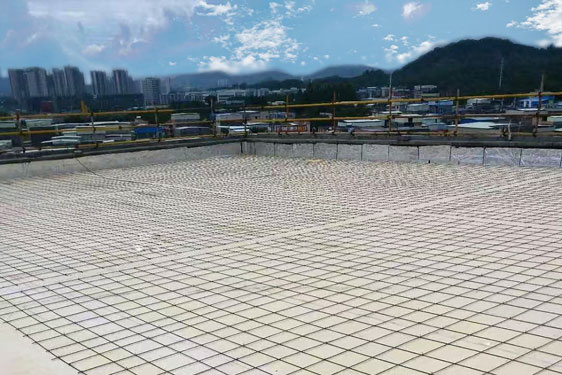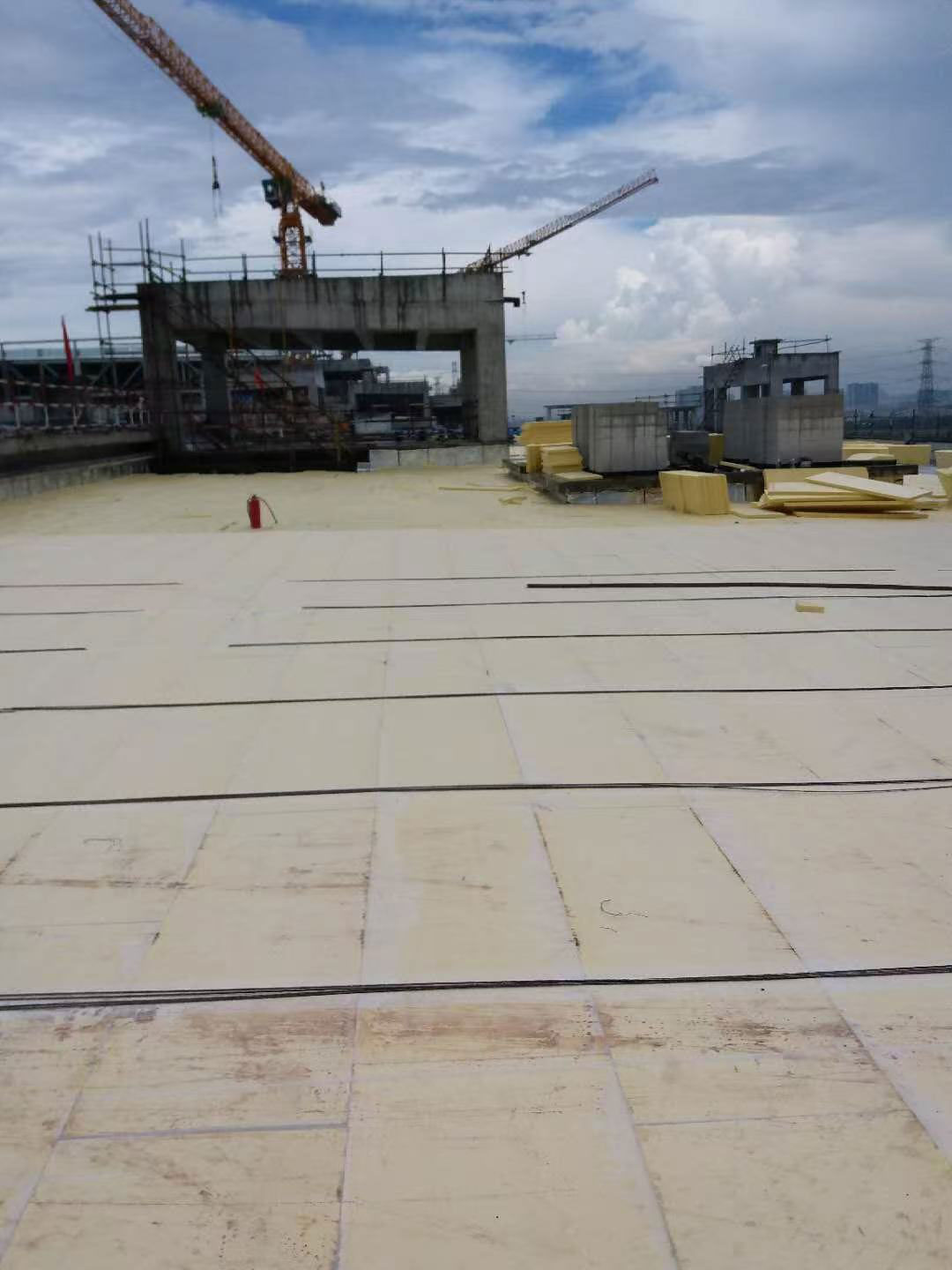Long-term commitment to the R & D and manufacturing of extruded board insulation materials, a new service platform
Production workshop feeding volume per hour 2 tons, daily output 1000 cubic meters

Extruded board for concrete roofs is a building material specially used for thermal insulation, heat insulation and moisture protection of concrete roofs. The following is a detailed introduction about it:
I. characteristics
1. Excellent heat insulation and insulation: Extruded board is mainly made of polystyrene, which is a good low thermal conductivity raw material in itself. It is supplemented by extrusion and extrusion to form a tight honeycomb structure, which can more effectively prevent heat conduction. The thermal conductivity coefficient is much lower than other insulation materials, such as EPS board, foamed polyurethane, insulation mortar, perlite, etc., which can effectively reduce heat transfer on the roof and keep the indoor temperature stable.
2. Superior water resistance and moisture resistance: The extruded board has a tight closed-cell structure. The polystyrene molecular structure itself does not absorb water. There are no gaps on the front and back of the board. The water absorption rate is extremely low. It has good moisture and permeation resistance. It can effectively prevent rainwater and moisture from penetrating into the interior of the concrete roof to avoid damage to the roof due to moisture.
3. Good compressive strength: Depending on different models and thicknesses, the compressive strength of extruded panels can reach more than 150-500Kpa. It can withstand various loads on the roof, including people walking, equipment placement, etc., and is not easy to deform or damage. It is suitable for various types of concrete roofs.
4. Anti-corrosion and long-lasting durability: General rigid foam insulation materials are prone to aging after several years of use, which will lead to performance degradation due to water absorption. Because of its excellent anti-corrosion and anti-aging properties, extruded boards can still maintain their excellent performance under high water vapor pressure, and their service life can reach 30-40 years.
5. Light texture and easy to use: The completely closed-cell foaming chemical structure and its honeycomb-like physical structure make it light and high-strength, easy to cut and transport, not easy to damage, easy to install, and can reduce construction difficulty and labor intensity.
6. Good environmental protection performance: The extruded board has been tested by relevant national departments to have stable chemical properties, does not volatilize harmful substances, and is harmless to the human body. The production raw materials are environmentally friendly materials, which do not produce any industrial pollution, and belongs to environmentally friendly building materials.
2. Type
1. Classification by compression strength and skin: Can be divided into X150 (Compression strength ≥150kPa, with skin), X200 (Compression strength ≥200kPa, with skin), X250 (Compression strength ≥250kPa, with skin), X300 (Compression strength ≥300kPa, with skin), X350 There are ten types including (compressive strength ≥350kPa, with skin), X400 (compressive strength ≥ 400kPa, with skin), X450 (compressive strength ≥450kPa, with skin), X500 (compressive strength ≥500kPa, with skin), W200 (compressive strength ≥200kPa, without skin), W300 (compressive strength ≥300kPa, without skin).
2. Classified by edge structure: There are mainly four types: SS flat-head products, Si products (lap joint), TG products (mortise and groove), and RC products (rain groove).

3. Construction Points
1. Roof base treatment: Before laying extruded boards, the concrete roof surface needs to be cleaned to remove dust, debris, oil, etc. to ensure that the surface is smooth, dry and solid.
2. Laying waterproof membrane: Lay a waterproof membrane on the cleaned roof surface and fix it on the outside of the wall to enhance the waterproof performance of the roof. The waterproof membrane should be laid neatly and closely fitted to the wall.
3. Install the corner line: Fix the corner line along the outer edge of the wall. During installation, attention should be paid to closely fit it with the waterproof membrane and ensure that it is perpendicular to the ground. The corner line can protect the edge of the extruded board and its appearance.
4. Laying extruded boards: Lay the extruded boards on the roof in predetermined positions. Cutting should be minimized during laying to avoid waste of material. At the same time, ensure that the gap between the extruded boards is as small as possible and closely fit with the corner line.
5. Fixing the extruded board: Use environmentally friendly glue to fix the extruded board on the roof. The glue should be evenly applied to the surface of the extruded board without gaps. After fixing, use a wooden stick or other tool to compact it to ensure it is firm. You can also install fasteners at the edge of the extruded board as needed to further fix its position.
6. Covering fire-proof cloth: Cover the extruded board with a layer of fire-proof cloth and fix it with glue. The fire-proof cloth should completely cover the surface of the extruded board and be closely attached to the corner line to improve the fire-proof performance of the roof.
7. Brush waterproof coating: Brush waterproof coating on the fireproof cloth to form a waterproof layer to further enhance the waterproof and moisture-proof properties of the roof.
I. characteristics
1. Excellent heat insulation and insulation: Extruded board is mainly made of polystyrene, which is a good low thermal conductivity raw material in itself. It is supplemented by extrusion and extrusion to form a tight honeycomb structure, which can more effectively prevent heat conduction. The thermal conductivity coefficient is much lower than other insulation materials, such as EPS board, foamed polyurethane, insulation mortar, perlite, etc., which can effectively reduce heat transfer on the roof and keep the indoor temperature stable.
2. Superior water resistance and moisture resistance: The extruded board has a tight closed-cell structure. The polystyrene molecular structure itself does not absorb water. There are no gaps on the front and back of the board. The water absorption rate is extremely low. It has good moisture and permeation resistance. It can effectively prevent rainwater and moisture from penetrating into the interior of the concrete roof to avoid damage to the roof due to moisture.
3. Good compressive strength: Depending on different models and thicknesses, the compressive strength of extruded panels can reach more than 150-500Kpa. It can withstand various loads on the roof, including people walking, equipment placement, etc., and is not easy to deform or damage. It is suitable for various types of concrete roofs.
4. Anti-corrosion and long-lasting durability: General rigid foam insulation materials are prone to aging after several years of use, which will lead to performance degradation due to water absorption. Because of its excellent anti-corrosion and anti-aging properties, extruded boards can still maintain their excellent performance under high water vapor pressure, and their service life can reach 30-40 years.
5. Light texture and easy to use: The completely closed-cell foaming chemical structure and its honeycomb-like physical structure make it light and high-strength, easy to cut and transport, not easy to damage, easy to install, and can reduce construction difficulty and labor intensity.
6. Good environmental protection performance: The extruded board has been tested by relevant national departments to have stable chemical properties, does not volatilize harmful substances, and is harmless to the human body. The production raw materials are environmentally friendly materials, which do not produce any industrial pollution, and belongs to environmentally friendly building materials.
2. Type
1. Classification by compression strength and skin: Can be divided into X150 (Compression strength ≥150kPa, with skin), X200 (Compression strength ≥200kPa, with skin), X250 (Compression strength ≥250kPa, with skin), X300 (Compression strength ≥300kPa, with skin), X350 There are ten types including (compressive strength ≥350kPa, with skin), X400 (compressive strength ≥ 400kPa, with skin), X450 (compressive strength ≥450kPa, with skin), X500 (compressive strength ≥500kPa, with skin), W200 (compressive strength ≥200kPa, without skin), W300 (compressive strength ≥300kPa, without skin).
2. Classified by edge structure: There are mainly four types: SS flat-head products, Si products (lap joint), TG products (mortise and groove), and RC products (rain groove).

3. Construction Points
1. Roof base treatment: Before laying extruded boards, the concrete roof surface needs to be cleaned to remove dust, debris, oil, etc. to ensure that the surface is smooth, dry and solid.
2. Laying waterproof membrane: Lay a waterproof membrane on the cleaned roof surface and fix it on the outside of the wall to enhance the waterproof performance of the roof. The waterproof membrane should be laid neatly and closely fitted to the wall.
3. Install the corner line: Fix the corner line along the outer edge of the wall. During installation, attention should be paid to closely fit it with the waterproof membrane and ensure that it is perpendicular to the ground. The corner line can protect the edge of the extruded board and its appearance.
4. Laying extruded boards: Lay the extruded boards on the roof in predetermined positions. Cutting should be minimized during laying to avoid waste of material. At the same time, ensure that the gap between the extruded boards is as small as possible and closely fit with the corner line.
5. Fixing the extruded board: Use environmentally friendly glue to fix the extruded board on the roof. The glue should be evenly applied to the surface of the extruded board without gaps. After fixing, use a wooden stick or other tool to compact it to ensure it is firm. You can also install fasteners at the edge of the extruded board as needed to further fix its position.
6. Covering fire-proof cloth: Cover the extruded board with a layer of fire-proof cloth and fix it with glue. The fire-proof cloth should completely cover the surface of the extruded board and be closely attached to the corner line to improve the fire-proof performance of the roof.
7. Brush waterproof coating: Brush waterproof coating on the fireproof cloth to form a waterproof layer to further enhance the waterproof and moisture-proof properties of the roof.